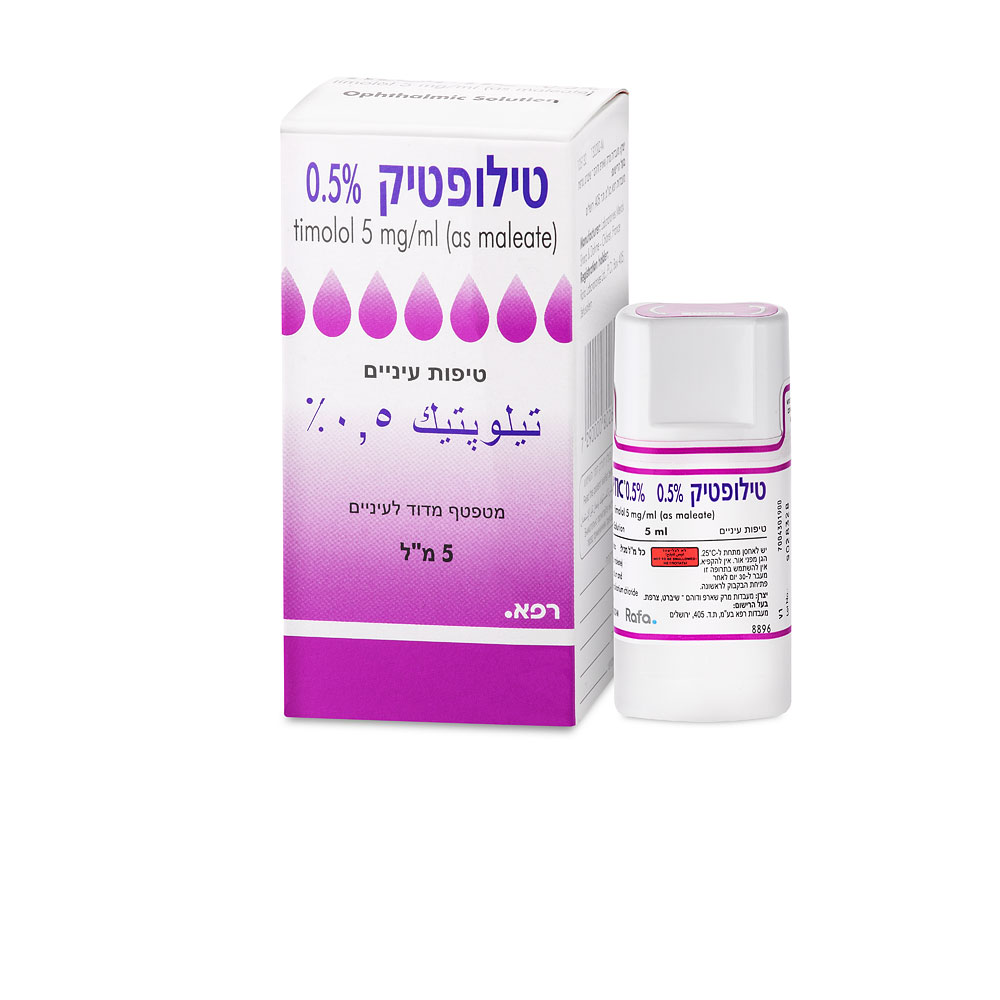Quest for the right Drug

טילופטיק % 0.5 TILOPTIC 0.5 % (TIMOLOL AS MALEATE)
תרופה במרשם
תרופה בסל
נרקוטיקה
ציטוטוקסיקה
צורת מתן:
עיני : OCULAR
צורת מינון:
טיפות עיניים : EYE DROPS, SOLUTION
עלון לרופא
מינוניםPosology התוויות
Indications תופעות לוואי
Adverse reactions התוויות נגד
Contraindications אינטראקציות
Interactions מינון יתר
Overdose הריון/הנקה
Pregnancy & Lactation אוכלוסיות מיוחדות
Special populations תכונות פרמקולוגיות
Pharmacological properties מידע רוקחי
Pharmaceutical particulars אזהרת שימוש
Special Warning עלון לרופא
Physicians Leaflet
Adverse reactions : תופעות לוואי
4.8 Undesirable effects Like other topically applied ophthalmic drugs, timolol is absorbed into the systemic circulation. This may cause similar undesirable effects as seen with systemic beta-blocking agents. Incidence of systemic ADRs after topical ophthalmic administration is lower than for systemic administration. The following adverse reactions have been reported with ocular administration of this or other timolol maleate formulations, either in clinical trials or since the drug has been marketed. Additional side effects have been reported in clinical experiences with systemic timolol maleate, and may be considered potential effects of ophthalmic timolol maleate. Also listed are adverse reactions seen within the class of ophthalmic beta- blockers and may potentially occur with ‘Tiloptic’. Eye disorders ocular: signs and symptoms of ocular irritation, (e.g. burning, stinging, itching, tearing, redness), conjunctivitis, blepharitis, keratitis, dry eyes, decreased corneal sensitivity, blurred vision, corneal erosion. Visual disturbances, including refractive changes (due to withdrawal of miotic therapy in some cases), diplopia, ptosis and choroidal detachment following filtration surgery (see 4.4 ‘Special warnings and precautions for use’). Cases of corneal calcification have been reported very rarely in association with the use of phosphate containing eye drops in some patients with significantly damaged corneas. Ear and labyrinth disorders: Ocular: tinnitus Cardiac disorders ocular: bradycardia, chest pain, arrhythmia, heart block, congestive heart failure, palpitations, cardiac arrest, cardiac failure, oedema; systemic: atrioventricular block (second- or third-degree), sino-atrial block, pulmonary oedema, worsening of arterial insufficiency, worsening of angina pectoris, vasodilation. Vascular disorders: ocular: claudication, hypotension, Raynaud's phenomenon, cold hands and feet. Respiratory, thoracic and mediastinal disorders: ocular: bronchospasm (predominantly in patients with pre-existing bronchospastic disease), respiratory failure, dyspnoea, cough; systemic: rales. General disorders and administration site conditions: ocular: asthenia, fatigue; systemic: extremity pain, decreased exercise tolerance. Skin and subcutaneous tissue disorders: ocular: alopecia, psoriasiform rash or exacerbation of psoriasis, skin rash; systemic: sweating, exfoliative dermatitis. Immune system disorders: ocular: systemic lupus erythematosus, pruritus; systemic: signs and symptoms of allergic reactions including anaphylaxis, angioedema, urticaria, localised and generalised rash, anaphylactic reaction. Psychiatric disorders: ocular: depression, insomnia, nightmares, memory loss, hallucinations. systemic: diminished concentration, increased dreaming. Nervous system disorders ocular: syncope, cerebrovascular accident, cerebral ischemia, headache, dizziness, increase in signs and symptoms of myasthenia gravis, paraesthesia. systemic: vertigo, local weakness. Gastrointestinal disorders: ocular: nausea, diarrhoea, dyspepsia, dry mouth, dysgeusia, abdominal pain, vomiting. Reproductive system and breast disorders: ocular: decreased libido, Peyronie’s disease, sexual dysfunction such as impotence; systemic: micturition difficulties. Metabolism and nutrition disorders: ocular: hypoglycaemia; systemic: hyperglycaemia. Musculoskeletal and connective tissue disorders: ocular: myalgia; systemic: arthralgia. Blood and lymphatic system disorders: systemic: non-thrombocytopenic purpura. Reporting of suspected adverse reactions Reporting suspected adverse reactions after authorisation of the medicinal product is important. It allows continued monitoring of the benefit/risk balance of the medicinal product. Any suspected adverse events should be reported to the Ministry of Health according to the National Regulation by using an online form ttps://sideeffects.health.gov.il

שימוש לפי פנקס קופ''ח כללית 1994
Chronic open angle glaucoma, aphakic glaucoma, secondary glaucoma, ocular hypertension
תאריך הכללה מקורי בסל
01/01/1995
הגבלות
תרופה שאושרה לשימוש כללי בקופ'ח
מידע נוסף
